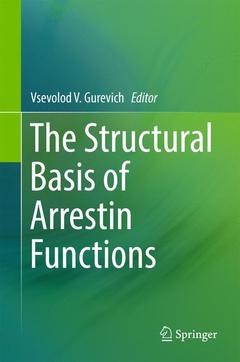The Structural Basis of Arrestin Functions, Softcover reprint of the original 1st ed. 2017
Coordonnateur : Gurevich Vsevolod V.

The chapters are written by the world-class specialists in the field, mostly the people who actually contributed the data discussed. The book gives coherent historical prospective and describes the most recent findings.
The book would be particularly useful for scientists in academia and industry working in the fields of pharmacology, cell biology, structural biology, and drug discovery. We expect that the focus on the molecular basis of protein-protein interactions would help to develop novel tools for engaging this important type of targets for research and therapeutic purposes.
Arrestins: discovery of the family and functional role of conformational flexibility.- Overview of arrestin-mediated signaling with receptors and non-receptor binding partners.- Initial crystallographic studies of visual arrestin: insights and perspectives.- Structural basis for b-arrestins in GPCR trafficking.- Arrestin-3: the structural basis of lower receptor selectivity.- Phosphate sensor and construction of phosphorylation-independent arrestins.- Comprehensive analysis of the role of arrestin residues in receptor binding.- How arrestin recognizes and binds active GPCRs.- Localization of conformational dynamics of arrestins by HDX-MS.- GPCR footprint on arrestins and manipulation of receptor specificity.- The structure of the polar core mutant R175E and its functional implications.- Active conformations of arrestins: expected and unexpected changes.- The arrestin-receptor complex: exciting answers and new questions.- Scaffolding c-Jun N-terminal kinase cascades: mechanistic insights from the reconstituted arrestin-JNK cascades.- Arrestin-dependent ERK activation and its disruption.- The functional role of the conformational changes in arrestin upon activation.- Is signaling specificity encoded in arrestin conformation?.- Monofunctional elements of multi-functional arrestin proteins.- Arrestins in cell death.
Gives a unique insight of the connection between protein structure and function of arrestin and its broad implications
Discussed are structure-based redesign of signalling proteins paves the way for novel approaches to gene therapy
Presents a unified view of the structural basis of the various branches of arrestin-mediated signalling
Includes supplementary material: sn.pub/extras
Includes supplementary material: sn.pub/extras
Date de parution : 06-2017
Ouvrage de 304 p.
15.5x23.5 cm
Disponible chez l'éditeur (délai d'approvisionnement : 15 jours).
Prix indicatif 168,79 €
Ajouter au panierDate de parution : 08-2018
Ouvrage de 304 p.
15.5x23.5 cm
Disponible chez l'éditeur (délai d'approvisionnement : 15 jours).
Prix indicatif 168,79 €
Ajouter au panierThème de The Structural Basis of Arrestin Functions :
Mots-clés :
GPCR; Cell Signalling; Protein Structure; Redesigning; Signalling Proteins



